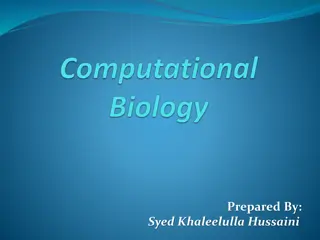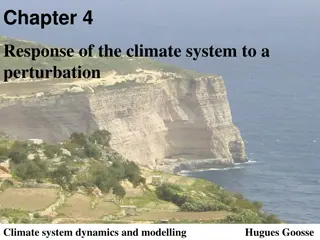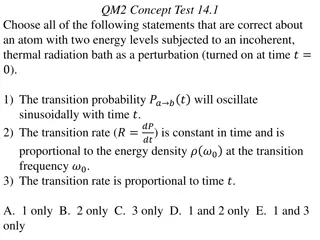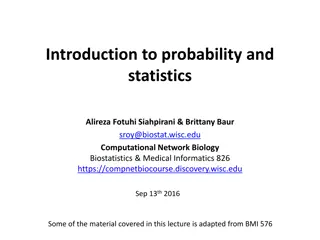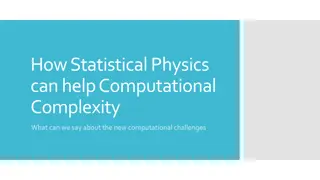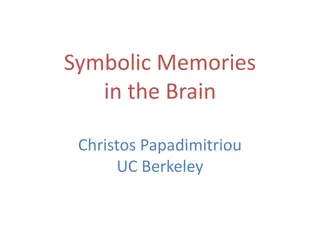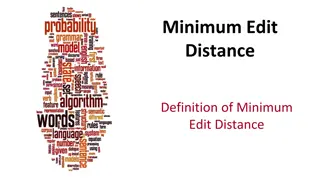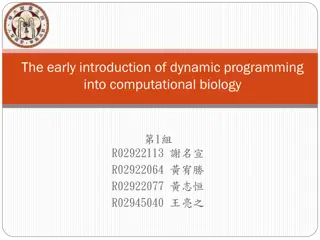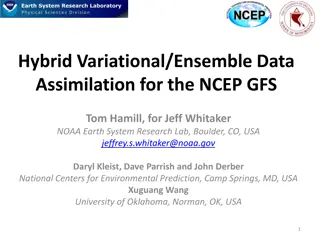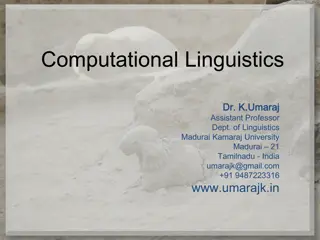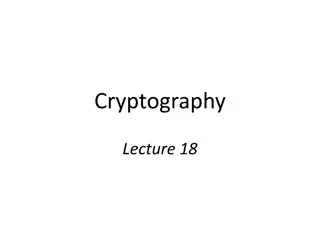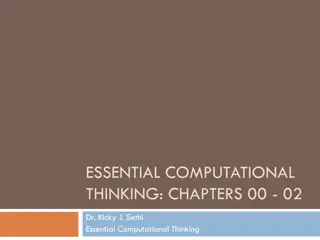Understanding Network Perturbations in Computational Biology
Network-based interpretation and integration play a crucial role in understanding genetic perturbations in biological systems. Perturbations in networks can affect nodes or edges, leading to valuable insights into gene function and phenotypic outcomes. Various algorithms, such as graph diffusion and probabilistic graphical models, are utilized to examine perturbations effectively. Factor graphs, a type of graphical model, offer a versatile framework for representing global functions as products of local functions. Probabilistic graphical models, like PARADIGM, aid in inferring patient-specific pathway activities from multi-dimensional cancer genomics data.
- Network Perturbations
- Computational Biology
- Genetic Perturbations
- Graphical Models
- Biological Systems
Download Presentation

Please find below an Image/Link to download the presentation.
The content on the website is provided AS IS for your information and personal use only. It may not be sold, licensed, or shared on other websites without obtaining consent from the author. Download presentation by click this link. If you encounter any issues during the download, it is possible that the publisher has removed the file from their server.
E N D
Presentation Transcript
Network-based interpretation and integration Sushmita Roy sroy@biostat.wisc.edu Computational Network Biology Biostatistics & Medical Informatics 826 https://compnetbiocourse.discovery.wisc.edu Nov 29th 2018
Perturbations in networks Understanding genetic perturbations are important in biology Genetic perturbations are useful to identify the function of genes What happens if knock gene A down? Measure some morphological phenotype like growth rate or cell size Measure global expression signatures Perturbations can be artificial or natural Artificial perturbations Deletion strains Natural perturbations Single nucleotide polymorphisms Natural genetic variation Perturbations in a network can affect Nodes or edges Edge perturbations Mutations on binding sites
Types of algorithms used to examine perturbations in networks Graph diffusion followed by subnetwork finding methods HOTNET Probabilistic graphical model-based methods Factor graphs Nested Effect Models (NEMs) Information flow-based methods (also widely used for integrating different types of data) Min cost max flow Prize collecting steiner tree
Probabilistic graphical models for interpreting network perturbations Inference of Patient-Specific Pathway Activities from Multi- Dimensional Cancer Genomics Data Using PARADIGM. Bioinformatics https://academic.oup.com/bioinformatics/article/2 6/12/i237/282591 C.-H. H. Yeang, T. Ideker, and T. Jaakkola, "Physical network models." Journal of computational biology : a journal of computational molecular cell biology, vol. 11, no. 2-3, pp. 243-262, Mar. 2004. F. Markowetz, D. Kostka, O. G. Troyanskaya, and R. Spang, "Nested effects models for high-dimensional phenotyping screens," Bioinformatics, vol. 23, no. 13, pp. i305-312, Jul. 2007. C. J. Vaske, C. House, T. Luu, B. Frank, C.-H. H. Yeang, N. H. Lee, and J. M. Stuart, "A factor graph nested effects model to identify networks from genetic perturbations." PLoS computational biology, vol. 5, no. 1, pp. e1 000 274+, Jan. 2009.
Factor graphs A type of graphical model A bi-partite graph with variable nodes and factor nodes Edges connect variables to potentials that the variables are arguments of Represents a global function as product of smaller local functions Perhaps the most general graphical model Bayesian networks and Markov networks have factor graph representations
Example factor graph Variable nodes Factor nodes From Kschischang, Frey, Loeliger 2001
Probabilistic graphical models for interpreting network perturbations Inference of Patient-Specific Pathway Activities from Multi- Dimensional Cancer Genomics Data Using PARADIGM. Bioinformatics https://academic.oup.com/bioinformatics/article/2 6/12/i237/282591 C.-H. H. Yeang, T. Ideker, and T. Jaakkola, "Physical network models." Journal of computational biology : a journal of computational molecular cell biology, vol. 11, no. 2-3, pp. 243-262, Mar. 2004. F. Markowetz, D. Kostka, O. G. Troyanskaya, and R. Spang, "Nested effects models for high-dimensional phenotyping screens," Bioinformatics, vol. 23, no. 13, pp. i305-312, Jul. 2007. C. J. Vaske, C. House, T. Luu, B. Frank, C.-H. H. Yeang, N. H. Lee, and J. M. Stuart, "A factor graph nested effects model to identify networks from genetic perturbations." PLoS computational biology, vol. 5, no. 1, pp. e1 000 274+, Jan. 2009.
Nested Effect Models Markowetz et al, 2007
Key properties of Factor Graph-NEMs (FG- NEMs) NEMs assume the genes that are perturbed interact in a binary manner But many interactions have sign inhibitory or stimulating action FG-NEMs capture a broader set of interactions among the perturbed genes Formulation based on a Factor Graph Provide an efficient search over the space of NEMs
Notation S-genes: Set of genes that have been deleted individually E-genes: Set of effector genes that are measured : The attachment of an effector gene to the S-gene network : The interaction matrix of S-genes X: The phenotypic profile, each column gives the difference in expression in a knockout compared to wild type Rows: E-genes Columns: S-genes Y: Hidden effect matrix, each entry is {-1, 0, +1} which specifies whether an S-gene affects the E-gene
Factor Graph Nested Effects Model An example of 4 S-genes and 13 E-gens A->C is reflected in the scatter plot. When XA is up, X C is up. When XA is down, XC is down or no change E-genes X B-ID is also reflected in the scatter plot. XD is a subset of opposite changes from XB S-genes Figure 1. Predicting Pair-wise Interaction Using Quantitative Nested Effects. (A) Hypothetical example with four S-genes,A,B,C,and D.The graph contains one inhibitory link, BxD (left). A heatmap of E-gene expression under knockdown of each S-gene shows both inhibitory and stimulatory effects(middle). Scatter plotsof theC,A,B,and Dknock-outsshow that expression fitsin theshaded preferred regionsof each interaction (right). The inhibitory link explains some of the observed data: expression changes under DD (bright red or bright green entries in the heatmap) occur in asubset of the E-genesfor which the oppositechangesoccur in DB.(B) Data from aknown inhibitory interaction.Expression levelsof effect genes under the DIG1/DIG2 knock-out (y-axis) plotted against their levels under the STE2 knock-out (x-axis) asdetected in [17]. Expression changes significant at a=0.05 indicated in gray lines. DIG1/DIG2 is known to inhibit STE12. (C) Interaction modes. Observed E-gene expression changes are compared to five possible types of interactionsbetween two S-genes, Aand B(i v). The top row illustrates the expected nested effects relationship for each type of interaction mode: circles represent sets of E-genes with expression changes consistent with either activation (blue circles) or inhibition (yellow circles).Scatter-plotsfor each interaction modeshow thehypothetical expression changesunder DA(x-axis) and DB(y-axis) for all E- genes(circles). E-gene levels are either consistent (filled) or inconsistent (open) with the mode. Shaded regions demark expression levels consistent with each interaction model.Theexample showsexpression changesthat most closely match theinhibition mode (indicated by thegreatest number of closed circles). doi:10.1371/journal.pcbi.1000274.g001 arelisted from top to bottom according to wherethey areattached to the network. Depending on the connections of the S-genes to one another and to the E-genes, a disruption in an S-gene will cause E-genesto either increase or decrease in expression relative to wild-type. For example, E-gene E7decreasesunder DB relative to wild-type because the wild-type activation by B isabsent in the deletion. On the other hand, the expression of E10also decreases under DB relative to wild-type but as a result of a different mechanism. In wild-type, E10is expressed at a baseline level because its repressor, the product of gene D, is inhibited by B s product. However, in the B deletion, D isderepressed, leading to inhibition of E10. This toy example illustrates that the disambig- uation of inhibition and activation, both for S-gene interactions and E-gene attachments, make it possible to account for an expanded set of mechanisms leading to the observed expression changes. TheE-geneexpression changesareavailable in adata matrix X where each column gives the difference in expression of each E- gene under thedeletion of a single S-gene relative to wild-type. X may also contain replicatesin theform of repeated S-gene knock- downs. The entry Xe A rrepresents e sexpression change under the rthreplicate of DA. Furthermore, we assume that an unknown expression state for each E-gene under each knock-down, determinesitsset of expression changesobserved acrossthe{Xe A r} replicatesin themicroarray data. Thematrix, Y, recordsahidden state for each E-gene under each knock-down, where entry Ye Ais thestate of E-gene eunder DA. Weallow thestatesto beternary- valued {+1, 2 1, 0} representing whether eisup-regulated, down- PLoSComputational Biology | www.ploscompbiol.org 3 January 2009 | Volume 5 | Issue 1 | e1000274
Factor Graph Nested Effects Model S-gene interaction modes and their expression signatures Interaction mode Figure 1. Predicting Pair-wise Interaction Using Quantitative Nested Effects. (A) Hypothetical example with four S-genes,A,B,C,and D.The graph contains one inhibitory link, BxD (left). A heatmap of E-gene expression under knockdown of each S-gene shows both inhibitory and stimulatory effects(middle). Scatter plotsof theC,A,B,and Dknock-outsshow that expression fitsin theshaded preferred regionsof each interaction (right). The inhibitory link explains some of the observed data: expression changes under DD (bright red or bright green entries in the heatmap) occur in asubset of the E-genesfor which the oppositechangesoccur in DB.(B) Data from aknown inhibitory interaction.Expression levelsof effect genes under the DIG1/DIG2 knock-out (y-axis) plotted against their levels under the STE2 knock-out (x-axis) asdetected in [17]. Expression changes significant at a=0.05 indicated in gray lines. DIG1/DIG2 is known to inhibit STE12. (C) Interaction modes. Observed E-gene expression changes are compared to five possible types of interactionsbetween two S-genes, Aand B(i v). The top row illustrates the expected nested effects relationship for each type of interaction mode: circles represent sets of E-genes with expression changes consistent with either activation (blue circles) or inhibition (yellow circles).Scatter-plotsfor each interaction modeshow thehypothetical expression changesunder DA(x-axis) and DB(y-axis) for all E- genes(circles). E-gene levels are either consistent (filled) or inconsistent (open) with the mode. Shaded regions demark expression levels consistent with each interaction model.Theexample showsexpression changesthat most closely match theinhibition mode (indicated by thegreatest number of closed circles). doi:10.1371/journal.pcbi.1000274.g001 Consistent with expectation Expected trend in E-genes for specific interaction modes Inconsistent with expectation arelisted from top to bottom according to wherethey areattached to the network. Depending on the connections of the S-genes to one another and to the E-genes, a disruption in an S-gene will cause E-genesto either increase or decrease in expression relative to wild-type. For example, E-gene E7decreasesunder DB relative to wild-type because the wild-type activation by B isabsent in the deletion. On the other hand, the expression of E10also decreases under DB relative to wild-type but as a result of a different mechanism. In wild-type, E10is expressed at a baseline level because its repressor, the product of gene D, is inhibited by B s product. However, in the B deletion, D isderepressed, leading to inhibition of E10. This toy example illustrates that the disambig- uation of inhibition and activation, both for S-gene interactions and E-gene attachments, make it possible to account for an expanded set of mechanisms leading to the observed expression changes. TheE-geneexpression changesareavailable in adata matrix X where each column gives the difference in expression of each E- gene under thedeletion of a single S-gene relative to wild-type. X may also contain replicatesin theform of repeated S-gene knock- downs. The entry Xe A rrepresents e sexpression change under the rthreplicate of DA. Furthermore, we assume that an unknown expression state for each E-gene under each knock-down, determinesitsset of expression changesobserved acrossthe{Xe A r} replicatesin themicroarray data. Thematrix, Y, recordsahidden state for each E-gene under each knock-down, where entry Ye Ais thestate of E-gene eunder DA. Weallow thestatesto beternary- valued {+1, 2 1, 0} representing whether eisup-regulated, down- PLoSComputational Biology | www.ploscompbiol.org 3 January 2009 | Volume 5 | Issue 1 | e1000274
Probabilistic model for NEMs Goal is to find a network, and that best fit the observed data (X) This is an inference problem Use a Maximum a posterior (MAP) approach Y encodes the true expression state of effector genes (X). X is a noisy measurement of Y. Y is the quantity we need to sum over
Factor Graph Nested Effects Model regulated, or unchanged under DA relative to wild-type respec- tively. Nested effects models include two sets of parameters. The parameter set W records all pair-wise interactions among the S- genes and the parameter set H describes how each E-gene is attached to the network of S-genes. In the original NEM formulations [10,15,18] W is a binary matrix with entry wA Bset to one if S-gene A acts above S-gene B and zero otherwise. If wA B= wBA= 1 then the S-genes are assumed to operate at an equivalent position in thepathway. Notethat indirect interactions are also represented in Wso that if wA B= 1 and wBC= 1 it implies wA C= 1. A parsimonious network among the S-genesissolved for by computing the transitive reduction of W. To allow for both stimulatory and inhibitory interactions in our formulation, wABcan assume six possible values for each uniqueunordered S-genepair {A, B}. Werefer to thesevaluesas inte raction mode s. The possible values are: (i) A activates B, AR B; (ii) A inhibitsB, AxB; (iii) A isequivalent to B, A= B; (iv) A does not interact with B, A? B; (v) B activates A, BR A; and (vi) B inhibits A, BxA. Plotting the response of E-genes under DA and DB yields a scatter-plot that may provideasignaturefor thetypeof interaction between A and B. For example, Figure 1B showsa scatter-plot of gene expression changes from the Hughes et al. (2000) yeast knock-out compendium [17] for a pair of knock-outs of the well- known pheromone-response genes: DSTE12 and the DDIG1/ DIG2 double knock-out. Comparing the scatter-plot for these pheromone-response genesto thepatternsin Figure 1C, it can be seen to match the inhibitory interaction mode more closely than the other modes, which is consistent with DIG1/ DIG2 s known inhibition of STE12. Figure 1C showsan exampleof thefirst four modes. Shaded regions denote consistent E-gene responses for each mode. An interaction mode determines a constraint on the observed E-gene expression changes. For example, plotting the expression changesof E-genesthat act downstream of either A or B for thegeneric A. B interaction modeproducespointsin oneof theseven shaded regionsshown in Figure 1Cv. Figure 1Cii shows an example where the inhibitory interaction mode is the best match to thedatabecauseahigher number of E-genechangesfall within consistent regions (filled circles in the figure). In this manner, genomewide expression changes detected on the micro- arrayscan beused asquantitative phenotypesto identify avariety of interactions between pairsof S-genes. Notethat two genesareequivalent if their knock-downslead to significantly similar expression changes, which may predict, for example, that they form a complex. Figure 1C also illustrates the generic interaction modeA. B used in an unsigned version of our method. WecompareFG-NEM resultstotwounsigned variantsto estimate the change in predictive power as a function of the introduction of sign. In effect, both variants consider four interaction modes: (i) A. B; (ii) B. A; (iii) A? B; and A= B. For comparison purposes, apredicted unsigned interaction wastreated asactivation. In the FG-NEM AVT variant, FG-NEM isrun on the absolute value of the data. In the uFG-NEM method, we remove the component of FG-NEM which models induced expression, resulting in interaction modeswherethetop and right five regions are disallowed in all interaction modes. J X ~ maxW ,H P W ,HjX 1 f g ( ) X ~ maxW ,H P W ,H,YjX 2 Y whereweintroducethehidden E-genestatesby summing over all possible configurations of theYmatrix. Applying Bayes Ruleand droppingP(X), which isconstant with respect tothemaximization, we obtain: ( ) X J X ~ maxW ,H P W P HjW P YjW ,H P XjY 3 Y ( ) X & maxW ,H P W P YjW ,H P XjY 4 Y Theapproximation in thelast step usestheassumption that any E- geneattachments are equally likely given a network structure; i.e. P(H| W) isassumed to be uniformly distributed and isignored in our approach. P(W) represents a prior over S-gene networks. Asin previousNEM formulations, weassumethat each E-gene is attached to a single S-gene and that each E-gene observation vector across the knock-downs is independent of other E-gene observations. The maximization function can then be written: Probabilistic model continued ( ) X J X ~ maxW ,H P W e[ EP YejW ,he P P XejYe 5 Y Independence over all E-genes ( ) X ~ maxW ,H P W P P YejW ,he P XejYe 6 e[ E Y Re-arranging the terms ~ maxW ,H P W P e[ ELe 7 whereXeand Yeare therow vectorsof data and hidden statesfor E-gene e respectively, and herecords the attachment point information for E-gene e . After rearranging the products and sums, weintroduce theshorthand Leto represent thelikelihood of the data restricted only to E-gene e . Previous approaches decompose Leover the knock-downs, which assume the S-gene observations are independent given the network and attachments (see [18] for an example of such a derivation). To facilitate scoring the expanded set of interaction modes mentioned earlier, we replace Le with a function proportional to Le, Le9 . Le9isdefined asa product of pair-wise S- gene terms: X L e~ P YeA, YeB P YeA,YeBjwAB,heAB P XeAjYeA P XeBjYeB 8 A,B[ S Probabilistic Formulation of NEMs Our goal isto find a structure among theS-genesthat provides a compact description of X. To find a network that best fits the data, we take a m axim umaposte riori approach asin [15,18] jointly identify Wand H that maximize the posterior: where he A Brepresents the attachment of E-gene erelative to the pair of S-genesA and B. Note that both he A Band wA Bareindexed by theunordered pair, {A, B}, so that wA Band wBAarereferences for the same variable. We refer to he A Base slocal attachm e nt which PLoSComputational Biology | www.ploscompbiol.org 4 January 2009 | Volume 5 | Issue 1 | e1000274
Factor Graph Nested Effects Model regulated, or unchanged under DA relative to wild-type respec- tively. Nested effects models include two sets of parameters. The parameter set W records all pair-wise interactions among the S- genes and the parameter set H describes how each E-gene is attached to the network of S-genes. In the original NEM formulations [10,15,18] W is a binary matrix with entry wA Bset to one if S-gene A acts above S-gene B and zero otherwise. If wA B= wBA= 1 then the S-genes are assumed to operate at an equivalent position in thepathway. Notethat indirect interactions are also represented in Wso that if wA B= 1 and wBC= 1 it implies wA C= 1. A parsimonious network among the S-genesissolved for by computing the transitive reduction of W. To allow for both stimulatory and inhibitory interactions in our formulation, wA Bcan assume six possible values for each uniqueunordered S-genepair {A, B}. Werefer to thesevaluesas inte raction mode s. The possible valuesare: (i) A activatesB, AR B; (ii) A inhibitsB, AxB; (iii) A isequivalent to B, A= B; (iv) A does not interact with B, A? B; (v) B activates A, BR A; and (vi) B inhibitsA, BxA. Plotting the response of E-genes under DA and DB yields a scatter-plot that may provideasignaturefor thetypeof interaction between A and B. For example, Figure 1B showsa scatter-plot of gene expression changes from the Hughes et al. (2000) yeast knock-out compendium [17] for a pair of knock-outs of the well- known pheromone-response genes: DSTE12 and the DDIG1/ DIG2 double knock-out. Comparing the scatter-plot for these pheromone-response genesto thepatternsin Figure 1C, it can be seen to match the inhibitory interaction mode more closely than the other modes, which is consistent with DIG1/ DIG2 s known inhibition of STE12. Figure1C showsan exampleof thefirst four modes. Shaded regions denote consistent E-gene responses for each mode. An interaction mode determines a constraint on the observed E-gene expression changes. For example, plotting the expression changesof E-genesthat act downstream of either A or Bfor thegeneric A. Binteraction modeproducespointsin oneof theseven shaded regionsshown in Figure1Cv. Figure 1Cii shows an example where the inhibitory interaction mode is the best match to thedatabecauseahigher number of E-genechangesfall within consistent regions (filled circles in the figure). In this manner, genomewide expression changes detected on the micro- arrayscan beused asquantitative phenotypesto identify avariety of interactions between pairsof S-genes. Notethat two genesareequivalent if their knock-downslead to significantly similar expression changes, which may predict, for example, that they form a complex. Figure 1C also illustrates the generic interaction modeA. B used in an unsigned version of our method. WecompareFG-NEM resultstotwounsigned variantsto estimate the change in predictive power as a function of the introduction of sign. In effect, both variants consider four interaction modes: (i) A. B; (ii) B. A; (iii) A? B; and A= B. For comparison purposes, apredicted unsigned interaction wastreated asactivation. In the FG-NEM AVT variant, FG-NEM isrun on the absolute value of the data. In the uFG-NEM method, we remove the component of FG-NEM which models induced expression, resulting in interaction modeswherethetop and right five regionsare disallowed in all interaction modes. J X ~ maxW ,H P W ,HjX 1 f g ( ) X ~ maxW ,H P W ,H,YjX 2 Y whereweintroducethehidden E-genestatesby summing over all possible configurationsof theYmatrix. Applying Bayes Ruleand droppingP(X), which isconstant with respect tothemaximization, we obtain: ( ) X J X ~ maxW ,H P W P HjW P YjW ,H P XjY 3 Y ( ) X & maxW ,H P W P YjW ,H P XjY 4 Y Theapproximation in thelast step usestheassumption that anyE- geneattachmentsareequally likely given a network structure; i.e. P(H| W) isassumed to be uniformly distributed and isignored in our approach. P(W) representsa prior over S-gene networks. Asin previousNEM formulations, weassumethat each E-gene is attached to a single S-gene and that each E-gene observation vector across the knock-downs is independent of other E-gene observations. The maximization function can then be written: ( ) X J X ~ maxW ,H P W e[ EP YejW ,he P P XejYe 5 Y ( ) X ~ maxW ,H P W P P YejW ,he P XejYe 6 e[ E Y ~ maxW ,H P W P e[ ELe 7 where Xeand Yearetherow vectorsof data and hidden statesfor E-gene e respectively, and herecords the attachment point information for E-gene e . After rearranging the products and sums, weintroduce theshorthand Leto represent thelikelihood of the data restricted only to E-gene e . Previous approaches decompose Leover the knock-downs, which assume the S-gene observations are independent given the Digging inside the Le term network and attachments (see [18] for an example of such a derivation). To facilitate scoring the expanded set of interaction modes mentioned earlier, we replace Le with a function proportional to Le, Le9 . Le9isdefined asa product of pair-wise S- gene terms: Note: Ye={YeA,YeB, YeC.. YeN}, where N is the total number of S- genes Define L e, proportional to Le using a set of pairwise potentials X L e~ P YeA, YeB P YeA,YeBjwAB,heAB P XeAjYeA P XeBjYeB 8 A,B[ S Probabilistic Formulation of NEMs Our goal isto find astructure among theS-genesthat provides a compact description of X. To find anetwork that best fits the data, we take a m axim umapo ste rio ri approach asin [15,18] jointly identify Wand H that maximize the posterior: where he A Brepresents the attachment of E-gene erelative to the pair of S-genesAand B. Notethat both he A Band wA Bareindexed by theunordered pair, {A, B}, so that wA Band wBAarereferences for the same variable. Werefer to he A Base slo cal attachm e nt which The S- gene interaction Attachment of gene e with respect to A or B PLoSComputational Biology | www.ploscompbiol.org 4 January 2009 | Volume 5 | Issue 1 | e1000274
Factor Graph Nested Effects Model constraint includesboth the direction of interactions and the sign of interactions. As S-gene interactions are signed, the transitivity constraint forcesthesign of theproduct of two edgesto equal the sign of the third; e.g. if AxB and BxC, then AR C. A result of modeling transitivity is that a directed cycle of stimulatory interactionswill also imply activation between any pair of S-genes in the cycle, in both directions. Therefore, the method clusters such S-genes into equivalence interactions. The product over r factors in Eq. (10) encode evidence from high-throughput assays, such as protein-protein binding and protein-DNA binding interactions (see Physical Structure Priors in Text S1). While network structures are constrained to reflect more intuitive models, the decomposition introduces interdependencies among theinteractions, adding complexity to thesearch for high- scoring networks. Importantly, max-sum message passing in a factor graph [19] providesan efficient meansfor estimating highly probable S-gene configurations. We next describe how the problem isrecoded into message-passing on a factor graph. can take on five possible values from the set {A, 2 A, B, 2 B, 0} representing that eiseither up- or down-regulated by A, attached and either up- or down-regulated by B, or not affected by either S- gene. wABdefinesthe mode of interaction between S-genesA and B. Assuming the replicates are independent given the E-gene states, P(Xe A| Ye A) can be written as a product over replicate r[ RAP XeArjYeA Digging inside the Le term terms: P , where P(Xe A r| Ye A) is modeled with a Gaussian distribution having mean m:YeAand standard deviation s estimated from the data (see Text S1). Substituting Le9 for Leinto Eq. (7) and distributing the maximization over attachment points, we obtain the maximizing function used in our approach: The S- gene interaction Attachment of gene e with respect to A or B Now the joint can be written in a more tractable way 8 < J X ~ maxW P W P max heAB : e[ E, A,B[ S 9 ) X P YeA,YeBjwAB,heAB P XeAjYeA P XeAjYeA Inference on Factor Graphs to Search for Candidate S- Gene Networks The formulation above provides a definition of the objective function tobemaximized but saysnothingabout how tosearch for agood network. Thesearch spaceof networksisvery largemaking exhaustive search [10] intractable for networkslarger than five S- genes. To apply themethod to larger networks, werequire a fast, heuristic approach. Markowetz et al. (2007) introduced a bottom- up techniquetoinfer an S-genegraph. They identify sub-graphsof S-genes(pairsand triples) and then mergethesub-graphstogether into a final parsimonious graph. Fro hlich et al. (2008) [18] use hierarchical clustering to first identify m odule s, subsets of S-genes with correlated expression changes. Networksamong themodules are exhaustively searched and a final network is identified by greedily introducing interactions acrossmodulesthat increase the likelihood. Here, weintroduce theuseof a graphical model called a factor graph to represent all possible NEM structures simultaneously. The parameters that determine the S-gene interactions, W, are explicitly represented asvariablesin thefactor graph. Identifying a high-scoring S-gene network istherefore converted to the task of identifying likely assignments of the W variables in the factor graph. A factor graph is a probabilistic graphical model whose likelihood function can be factorized into smaller terms (factors) representing local constraints or valuations on a set of random variables. Other graphical models, such asBayesian networksand Markov random fields, havestraightforward factor graph analogs. A factor graph can be represented as an undirected, bi-partite graph with two typesof nodes: variablesand factors. A variable is adjacent to a factor if the variable appearsasan argument of the factor. Factor graphsgeneralize probability massfunctions asthe joint likelihood function requiresno normalization and thefactors need not be conditional probabilities. Each factor encodesa local constraint pertaining to a few variables. YeA,YeB Each of these conditional distributions will correspond to a factor Theinteraction factorsP(Ye A, Ye B| wA B, he A B)haveavalueof oneif the E-gene eisattached to either A or B and e sstate isconsistent with the interaction mode between A and B. If e s state is inconsistent with the interaction and attachment, then the factor hasvaluezero. Whileweused hard constraintstomodel consistent and inconsistent expression changes (corresponding to the rigid boundaries of the regions drawn in Figure 1C), such constraints could besoftened to usefactorswith belief potentialsbetween zero and one. Notethat, to simplify theexample, theinteraction modes in Figure 1C show defined regions. However, P(Xe A| Ye A) is modeled asaGaussian distribution and thereforeassignsnon-zero probabilities over all possible expression values rather than classifying some asallowed and othersdisallowed (i.e. probability zero). An Interaction Transitivity Prior The prior over interactions, P(W), can represent preferences over specific interactions in the S-gene graph, allowing the incorporation of biologically-motivated network search. For example, the interaction priors for genes in a common pathway or geneswhose productshave been detected to interact in protein-protein interaction screens could be set higher than thepriorsfor arbitrary pairsof S-genes. In thisstudy, we chose to test the approach both with and without external biological information. Without external biological information, the prior encodes a basic property of the S-gene graph: that it should exhibit transitivity to force pair-wise interaction modes to beconsistent amongall triples. Usingtransitivity, all pathsbetween any two genes, A and B, are guaranteed to have the same overall effect; i.e. theproduct of thesignsof individual linksalongdifferent pathsbetween A and B are equal. In order to preserve the transitivity of identified interaction modes, the prior is decomposed over interaction configurations into transitivity constraints on all triplesof S-genes; i.e.: constraints to guide The Factor Graph for Nested Effects Figure 2 showsthe factor graph representing the NEM for the exampleS-genenetwork from Figure1A. Each random variableis represented by a circle and each conditional probability term in Eqs. (9 10) isrepresented by a square. Thefactor graph contains three types of variables. First, every unique unordered pair of S- genes{A,B} hasacorresponding variable, wA B, that takeson values equal to one of the previously mentioned interaction modes (Figure 2, S-Gene Interactions level). Second, every E-gene-S- gene pair is associated with a variable, Ye Afor the hidden P W ! A,B,C[ StABC wAB,wBC,wAC P A,B[ SrABwAB P 10 wheret iszero if thetripleof interactionsareintransitive, and one if the interactions are transitive (see Text S1 for full definition). Using transitivity constraints forces the search to find consistent models that best explain the observed changes. The transitivity PLoSComputational Biology | www.ploscompbiol.org 5 January 2009 | Volume 5 | Issue 1 | e1000274
Factor Graph Nested Effects Model constraint includesboth the direction of interactions and the sign of interactions. As S-gene interactions are signed, the transitivity constraint forcesthesign of theproduct of two edgesto equal the sign of the third; e.g. if AxB and BxC, then AR C. A result of modeling transitivity is that a directed cycle of stimulatory interactionswill also imply activation between any pair of S-genes in the cycle, in both directions. Therefore, the method clusters such S-genes into equivalence interactions. The product over r factors in Eq. (10) encode evidence from high-throughput assays, such as protein-protein binding and protein-DNA binding interactions (see Physical Structure Priors in Text S1). While network structures are constrained to reflect more intuitive models, the decomposition introduces interdependencies among theinteractions, adding complexity to thesearch for high- scoring networks. Importantly, max-sum message passing in a factor graph [19] providesan efficient meansfor estimating highly probable S-gene configurations. We next describe how the problem isrecoded into message-passing on a factor graph. can take on five possible values from the set {A, 2 A, B, 2 B, 0} representing that eiseither up- or down-regulated by A, attached and either up- or down-regulated by B, or not affected by either S- gene. wABdefinesthe mode of interaction between S-genesA and B. Assuming the replicates are independent given the E-gene states, P(Xe A| Ye A) can be written as a product over replicate terms: P , where P(Xe A r| Ye A) is modeled with a Gaussian distribution having mean m:YeAand standard deviation s estimated from the data (see Text S1). Substituting Le9 for Leinto Eq. (7) and distributing the maximization over attachment points, we obtain the maximizing function used in our approach: r[ RAP XeArjYeA 8 < J X ~ maxW P W P max heAB : Defining the factors e[ E, A,B[ S 9 ) X P YeA,YeBjwAB,heAB P XeAjYeA P XeAjYeA Inference on Factor Graphs to Search for Candidate S- Gene Networks The formulation above provides a definition of the objective function tobemaximized but saysnothingabout how tosearch for agood network. Thesearch spaceof networksisvery largemaking exhaustive search [10] intractable for networkslarger than five S- genes. To apply themethod to larger networks, werequire a fast, heuristic approach. Markowetz et al. (2007) introduced a bottom- up techniquetoinfer an S-genegraph. They identify sub-graphsof S-genes(pairsand triples) and then mergethesub-graphstogether into a final parsimonious graph. Fro hlich et al. (2008) [18] use hierarchical clustering to first identify m odule s, subsets of S-genes with correlated expression changes. Networksamong themodules are exhaustively searched and a final network is identified by greedily introducing interactions acrossmodulesthat increase the likelihood. Here, weintroduce theuseof a graphical model called a factor graph to represent all possible NEM structures simultaneously. The parameters that determine the S-gene interactions, W, are explicitly represented asvariablesin thefactor graph. Identifying a high-scoring S-gene network istherefore converted to the task of identifying likely assignments of the W variables in the factor graph. A factor graph is a probabilistic graphical model whose likelihood function can be factorized into smaller terms (factors) representing local constraints or valuations on a set of random variables. Other graphical models, such asBayesian networksand Markov random fields, havestraightforward factor graph analogs. A factor graph can be represented as an undirected, bi-partite graph with two typesof nodes: variablesand factors. A variable is adjacent to a factor if the variable appearsasan argument of the factor. Factor graphsgeneralize probability massfunctions asthe joint likelihood function requiresno normalization and thefactors need not be conditional probabilities. Each factor encodesa local constraint pertaining to a few variables. YeA,YeB Modeled as Gaussian distributions Theinteraction factorsP(Ye A, Ye B| wA B, he A B)haveavalueof oneif the E-gene eisattached to either A or B and e sstate isconsistent with the interaction mode between A and B. If e s state is inconsistent with the interaction and attachment, then the factor hasvaluezero. Whileweused hard constraintstomodel consistent and inconsistent expression changes (corresponding to the rigid boundaries of the regions drawn in Figure 1C), such constraints could besoftened to usefactorswith belief potentialsbetween zero and one. Notethat, to simplify theexample, theinteraction modes in Figure 1C show defined regions. However, P(Xe A| Ye A) is modeled asaGaussian distribution and thereforeassignsnon-zero probabilities over all possible expression values rather than classifying some asallowed and othersdisallowed (i.e. probability zero). Four variable factor, over discrete variables YeA:binary variables Four values for each possible type of interaction: inhibitory, activating, equivalent, no interaction Interaction of ewith A or B: inhibited or activated by A or B or no action This factor has value=1 if the E-gene e is attached to either A or B and e s state is consistent with the interaction mode between A and B. An Interaction Transitivity Prior The prior over interactions, P(W), can represent preferences over specific interactions in the S-gene graph, allowing the incorporation of biologically-motivated network search. For example, the interaction priors for genes in a common pathway or geneswhose productshave been detected to interact in protein-protein interaction screens could be set higher than thepriorsfor arbitrary pairsof S-genes. In thisstudy, we chose to test the approach both with and without external biological information. Without external biological information, the prior encodes a basic property of the S-gene graph: that it should exhibit transitivity to force pair-wise interaction modes to beconsistent amongall triples. Usingtransitivity, all pathsbetween any two genes, A and B, are guaranteed to have the same overall effect; i.e. theproduct of thesignsof individual linksalongdifferent pathsbetween A and B are equal. In order to preserve the transitivity of identified interaction modes, the prior is decomposed over interaction configurations into transitivity constraints on all triplesof S-genes; i.e.: constraints to guide The Factor Graph for Nested Effects Figure 2 showsthe factor graph representing the NEM for the exampleS-genenetwork from Figure1A. Each random variableis represented by a circle and each conditional probability term in Eqs. (9 10) isrepresented by a square. Thefactor graph contains three types of variables. First, every unique unordered pair of S- genes{A,B} hasacorresponding variable, wA B, that takeson values equal to one of the previously mentioned interaction modes (Figure 2, S-Gene Interactions level). Second, every E-gene-S- gene pair is associated with a variable, Ye Afor the hidden P W ! A,B,C[ StABC wAB,wBC,wAC P A,B[ SrABwAB P 10 wheret iszero if thetripleof interactionsareintransitive, and one if the interactions are transitive (see Text S1 for full definition). Using transitivity constraints forces the search to find consistent models that best explain the observed changes. The transitivity PLoSComputational Biology | www.ploscompbiol.org 5 January 2009 | Volume 5 | Issue 1 | e1000274
Factor Graph Nested Effects Model constraint includesboth the direction of interactionsand the sign of interactions. As S-gene interactions are signed, the transitivity constraint forcesthesign of theproduct of two edgesto equal the sign of the third; e.g. if AxB and BxC, then AR C. A result of modeling transitivity is that a directed cycle of stimulatory interactionswill also imply activation between any pair of S-genes in the cycle, in both directions. Therefore, the method clusters such S-genes into equivalence interactions. The product over r factors in Eq. (10) encode evidence from high-throughput assays, such as protein-protein binding and protein-DNA binding interactions (see Physical Structure Priors in Text S1). While network structures are constrained to reflect more intuitive models, the decomposition introduces interdependencies among theinteractions, adding complexity to thesearch for high- scoring networks. Importantly, max-sum message passing in a factor graph [19] providesan efficient meansfor estimating highly probable S-gene configurations. We next describe how the problem isrecoded into message-passing on a factor graph. can take on five possible values from the set {A, 2 A, B, 2 B, 0} representing that eiseither up- or down-regulated by A, attached and either up- or down-regulated by B, or not affected byeither S- gene. wA Bdefinesthe mode of interaction between S-genesA and B. Assuming the replicates are independent given the E-gene states, P(Xe A| Ye A) can be written as a product over replicate terms: P , where P(Xe A r| Ye A) is modeled with a Gaussian distribution having mean m:YeAand standard deviation s estimated from the data (see Text S1). Substituting Le9 for Leinto Eq. (7) and distributing the maximization over attachment points, we obtain the maximizing function used in our approach: r[ RAP XeArjYeA 8 < J X ~ maxW P W P max heAB : e[ E, A,B[ S 9 ) X P YeA,YeBjwAB,heAB P XeAjYeA P XeAjYeA Inference on Factor Graphs to Search for Candidate S- Gene Networks The formulation above provides a definition of the objective function tobemaximized but saysnothingabout howtosearch for agood network. Thesearch spaceof networksisvery largemaking exhaustive search [10] intractable for networkslarger than fiveS- genes. To apply themethod to larger networks, werequire afast, heuristic approach. Markowetz et al. (2007) introduced a bottom- up techniquetoinfer an S-genegraph. Theyidentify sub-graphsof S-genes(pairsand triples) and then mergethesub-graphstogether into a final parsimonious graph. Fro hlich et al. (2008) [18] use hierarchical clustering to first identify m o dule s, subsets of S-genes with correlated expression changes. Networksamong themodules are exhaustively searched and a final network is identified by greedily introducing interactions acrossmodulesthat increase the likelihood. Here, weintroduce theuseof agraphical model called afactor graph to represent all possible NEM structures simultaneously. The parameters that determine the S-gene interactions, W, are explicitly represented asvariablesin thefactor graph. Identifying a high-scoring S-gene network istherefore converted to the task of identifying likely assignments of the W variables in the factor graph. A factor graph is a probabilistic graphical model whose likelihood function can be factorized into smaller terms (factors) representing local constraints or valuations on a set of random variables. Other graphical models, such asBayesian networksand Markov random fields, havestraightforward factor graph analogs. A factor graph can be represented as an undirected, bi-partite graph with two typesof nodes: variablesand factors. A variable is adjacent to a factor if thevariable appearsasan argument of the factor. Factor graphsgeneralize probability massfunctionsasthe joint likelihood function requiresno normalization and thefactors need not beconditional probabilities. Each factor encodesa local constraint pertaining to a few variables. YeA,YeB Theinteraction factorsP(Ye A, Ye B| wA B, he A B)haveavalueof oneif theE-gene eisattached to either A or B and e sstate isconsistent with the interaction mode between A and B. If e s state is inconsistent with the interaction and attachment, then the factor hasvaluezero. Whileweused hard constraintstomodel consistent and inconsistent expression changes (corresponding to the rigid boundaries of the regions drawn in Figure 1C), such constraints could besoftened to usefactorswith belief potentialsbetween zero and one. Notethat, to simplify theexample, theinteraction modes in Figure 1C show defined regions. However, P(Xe A| Ye A) is modeled asaGaussian distribution and thereforeassignsnon-zero probabilities over all possible expression values rather than classifying some asallowed and othersdisallowed (i.e. probability zero). An Interaction Transitivity Prior The prior over interactions, P(W), can represent preferences over specific interactions in the S-gene graph, allowing the incorporation of biologically-motivated constraints to guide network search. For example, the interaction priors for genes in a common pathway or geneswhose productshave been detected to interact in protein-protein interaction screens could be set higher than thepriorsfor arbitrary pairsof S-genes. In thisstudy, we chose to test the approach both with and without external biological information. Without external biological information, the prior encodes a basic property of the S-gene graph: that it should exhibit transitivity to force pair-wise interaction modes to beconsistent amongall triples. Usingtransitivity, all pathsbetween any two genes, A and B, are guaranteed to havethe same overall The prior over S-gene graph effect; i.e. theproduct of thesignsof individual linksalongdifferent pathsbetween A and B are equal. In order to preserve the transitivity of identified interaction modes, the prior is decomposed over interaction configurations into transitivity constraints on all triplesof S-genes; i.e.: The prior P( ) can incorporate prior knowledge of interactions among genes in pathways At its simplest, it should encode a transitivity relationship to force all pairwise interactions to be consistent among all triples The Factor Graph for Nested Effects Figure 2 showsthe factor graph representing the NEM for the exampleS-genenetwork from Figure1A. Each random variableis represented by a circle and each conditional probability term in Eqs. (9 10) isrepresented by a square. Thefactor graph contains three typesof variables. First, every unique unordered pair of S- genes{A,B} hasacorrespondingvariable, wA B,that takeson values equal to one of the previously mentioned interaction modes (Figure 2, S-Gene Interactions level). Second, every E-gene-S- gene pair is associated with a variable, Ye Afor the hidden P W ! A,B,C[ StABCwAB,wBC,wAC Transitivity constraint for triples P A,B[ SrABwAB Physical network constraints P 10 wheret iszero if thetripleof interactionsareintransitive, and one if the interactions are transitive (see Text S1 for full definition). Using transitivity constraints forces the search to find consistent models that best explain the observed changes. The transitivity If A B, B C, Then, A->C Example transitivity: PLoSComputational Biology | www.ploscompbiol.org 5 January 2009 | Volume 5 | Issue 1 | e1000274
Factor graph representation of NEMs Factor Graph Nested Effects Model framework predict new members that act in the pathway by attaching E-genes to S-genes in the network, or leaving them detached if their expression data doesnot fit themodel. Attaching E-gene, e , to S-gene, s, assertsthat theexpression changesof eover all knock-downs are best explained by a network in which e is directly downstream of s. TheE-genesattached to thenetwork are collectively referred to asthe frontie r. Frontier genesmay be good candidates for further characterization (e.g. knock-down and expression profiling) in subsequent experiments. To gain a global picture for where eis connected, we use a modified NEM scoring from Markowetz et al. (2005). The pair- wise attachments for a single E-gene connection variable he A B, provide local best guesses for e s attachment. Rather than aggregate e scollection of local attachments, weuseNEM scoring, modified to incorporate both stimulatory and inhibitory attach- ments, to estimate the attachment point using the full network learned in the previous step (see Text S1). We calculate a log-likelihood ratio that measuresthe degree to which e s expression data is explained by the network if it is attached to one of the S-genes compared to being disconnected from the network, i.e. itslikelihood wasgenerated entirely by the background Gaussian distribution. For E-gene e , we compute the log-likelihood of attachment ratio (LAR): Prior Figure 2. Structure of the factor graph for network inference. The factor graph consists of three classes of variables(circles) and three classes of factors (squares). Xe A ris a continuous observation of E-gene e s expression under DA and replicate r. Ye Ais the hidden state of E- geneeunder DA,and isadiscrete variable with domain {up,,down}.wA B is the interaction between two S-genes A and B. Expression Factors model expression as a mixture of Gaussian distributions. Interaction Factors constrain E-gene states to the allowed regions shown in Figure 1C. Transitivity Factors constrain pair-wise interactions to form consistent triangles. The arrows labeled m and m 9 are messages encoding local belief potentials on wA Band are propagated during factor graph inference. doi:10.1371/journal.pcbi.1000274.g002 0 1 max @ i= 0P XejW ,he~ i P XejW ,he~ 0 A, LAR e ~ log wherehehererepresentsMarkowetz et. al sattachment parameter expanded to include inhibitory and stimulatory attachments. We rank all of theE-genesaccording to their LAR scores. Top-scoring geneshave data that ismore likely to have arisen from the model than anull background. Any E-genethat hasapositiveLAR score isincluded asa frontier gene. expression state of effect gene eunder knock-down A, (Figure 2, E-gene Expression State level). Third, every observed expres- sion value is associated with a continuous variable, Xe A r, where r indexes over replications of DA (Figure 2, E-gene Expression Observation level). Figure 2 also shows the expression factors, interaction factors, and transitivity factorsof Eqs. (9 10). Inference with message passing. the posterior is found using max-sum message passing using all terms from Eqs. (9 10) in log space. For acyclic graphs, the marginal, max-marginal and conditional probabilities of single or multiple variables can be exactly calculated by the max-sum algorithms [19]. Message-passing excellent empirical results in various practical problems even on graphscontaining cyclessuch asfeed-forward and feed-back loops [20 23]. Here, the message passing schedule performs inference in two steps. In the first step, messages from observations nodesXe A rare passed through the expression factors and hidden E-gene state variables, to calculate all messagesm (YAR wA B) in a single upward pass. In the second step, messages are passed between only the interaction variablesand transitivity factorsuntil convergence (see Text S1). In the example shown in Figure 2, running inference results in assignments of activation for wA Band wBC(shaded red), inhibition for wBDand wA D(shaded green), and non-interaction for wA Band wBC(unshaded), which match the NEM structure from Figure 1A. For display of inferred S-gene networks, we compute thetransitive reduction of Wby removing all linksfor which there isa longer redundant path [24]. Pathway expansion with FG-NEMs. network is identified using the message passing inference procedure above, the network can be used to search for new genesthat may be part of the pathway. The NEM and FG-NEM Experimental Validation Procedure for Newly Predicted Cancer Invasion Genes To validate the involvement of predicted invasiveness frontier genes, HT29 colon cancer cells were resuspended in DMEM medium containing 0.1% FBS and seeded into the top wells (26 105per well) containing individual Matrigel inserts (BD Biosciences, San Jose, CA) according to manufacturer s protocol. The lower wells were filled with 800 m l medium with 10% fetal bovine serum as chemoattractant. Six to ten hours following seeding, the cells in the upper wells were transfected with the appropriate shRNA-expressing pSuper constructs [25] using Lipofectamine 2000 (Invitrogen, Carlsbad, CA). Final concentra- tion of pSuper constructs was 1.6 m g/ ml. The transfected cells were incubated at 37uC for 48 hoursbeforeassaying for invasion. Media was aspirated from the top wells and non-invading cells werescraped from theupper sideof theinsertswith acotton swab and invading cellson the lower side were fixed and stained using DiffQuick (IMEB, Inc. San Marcos, CA). Total number of invading cellswascounted for each insert usingalight microscope. Invasion was assessed in quadruplicate and independently repeated at least five times. The shRNA-expressing portion of theconstruct wasdesigned using thesiRNA Selection Program of the Whitehead Institute for Biomedical Research (http:/ / jura.wi. mit.edu/ bioc/ siRNAext/ ), synthesized by Invitrogen and sub- cloned into the XhoI and BamHI sites of pSuper plasmid. Sequences for shRNA constructs are available in the Text S1. shRNA construct MYO1G targets the myosin 1G mRNA (GenBank accession number NM _033054). shRNA construct The W that maximizes algorithms demonstrate Once a signaling PLoSComputational Biology | www.ploscompbiol.org 6 January 2009 | Volume 5 | Issue 1 | e1000274
Inference on the factor graph Find most likely configurations for Use a message passing algorithm called the Max-Product algorithm (standard for factor graphs) Message passing happens in two steps Messages are passed from observations XeA to the Messages are passed between the interaction and transitivity factors until convergence
Factor Graph Nested Effects Model BMPR1A targets the bone morphogenetic protein receptor, type IA mRNA (NM_004329). shRNA construct COLEC12 targetsthe collectin sub-family member 12 mRNA (NM_130386). shRNA construct AA099748 targets an expressed sequence tag mRNA (AA099748). shRNA construct CAPN12 targets the calpain 12 mRNA (NM_144691). shRNA construct scrambled serves as a nonsense sequence negative control. network. In this case, whether the interaction was inhibitory or stimulatory wasignored. 2) We measured sig n re cove ry: a predicted interaction wasrecorded ascorrect if it matched an interaction in the simulated network and had the matching sign. Influence of inhibition extent on network recovery. tested the ability of FG-NEMs and uFG-NEMs to recover the structure of networks simulated with varying fractions of inhibition, 0# l # 0.75, for both the amount of inhibitory connections between S-genes and inhibitory attachments of E- genes. We simulated and predicted 500 networks, calculated the area under the precision-recall curve (AUC) for each predicted network (see Text S1), and recorded the mean and standard deviation of these AUCs. As expected, when no inhibition was present, FG-NEM and uFG-NEM were equivalent in terms of AUC when run on non-transformed Surprisingly, FG-NEM run on the AVT data performs much worsethan FG-NEM even with no inhibition. Thismay bedueto itsinterpretation of unaffected E-genechangesasaffected changes which adds noise to its estimates of hierarchical nesting. As increasing amountsof inhibition isadded into simulated networks, theperformanceof uFG-NEM degradesprecipitously for structure recovery, underperforming FG-NEM by a margin of more than 0.20 units of AUC at the highest levels of simulated inhibition (Figure 3A). Even at moderate levelsof inhibition, for example at the 15% inhibition level, FG-NEM sAUC isalready significantly higher than uFG-NEM s AUC. We also calculated the AUC for recovering the correct sign of the interactions for the unsigned models. In thiscase, unsigned interactions were interpreted to be activating interactions. As expected, quadratically since both the precision and recall decrease linearly with increasing fraction of inhibition. Given these results, we expect FG-NEMs to have significantly performance on real genetic networks where appreciable amounts of inhibition exist (see Figure S1). We also varied other We Results Results on Artificial Networks Data. We evaluated FG-NEMs ability to recover artificial networksfrom simulated data. Datawasgenerated by propagating signals in networks containing simulated knock-downs and then sampling expression data from activated, inhibited, or unaffected expression change distributions (see Text S1 and Figure S3). We focused on how the FG-NEM approach increased recovery of networksthat contain both activation and inhibition. BecauseFG- NEMsexplicitly incorporate inhibition, wehypothesized that they would recover networks containing an appreciable amount of inhibition more accurately than an approach lacking separate modesfor inhibition and activation. Weimplemented aversion of FG-NEM in which inhibition encoded in theFG-NEM model was removed (seeMethods). Werefer to thisversion asthe unsigned FG-NEM (uFG-NEM). We compared uFG-NEM to the original NEM approach and found that the results were comparable on small synthetic networksof four S-genesand their associated data (see Figure S2). We therefore used uFG-NEMsasa surrogate for NEMs for the tests on larger networks on which NEM was not efficient enough to run. To make the comparison of FG-NEM to uFG-NEM fair, we measured network recovery in two ways. 1) We calculated a measure of structure re cove ry: a predicted interaction was called correct if it matched an interaction (of either sign)in thesimulated data (Figure 3A). the AUC decreases better Does FG-NEM capture activating and inhibitory relationships? FG-NEM: capture inhibitory and activating relationships uFG-NEM: capture only unsigned interactions FG-NEM AVT: FG-NEM run on absolute value data Solid lines: structure recovery Dashed lines: sign recovery Figure 3. Accuracy of artificial network recovery and expansion. (A) Influence of inhibition on network recovery. AUC(y-axis) plotted as a function of the percent of inhibitory links (x-axis). Four replicate hybridizations were used in all simulations. Points and error bars represent means and standard deviations computed across 500 synthetically generated networks respectively. Lines in each plot represent the performance of FG- NEM (red) and uFG-NEM run on the original data (green) or on AVT data (blue) for both structure recovery (solid lines) and sign recovery (dotted lines). (B) Accuracy of FG-NEM network expansion compared to Template Matching. The percentile of an S-gene obtained from Template Matching was subtracted from the percentile of the LARscore (see Methods) assigned by FG-NEM and uFG-NEM obtained from the leave-one-out expansion test. A smoothed histogram for FG-NEM (red), uFG-NEM run on the original data (green) and the AVT data (blue) was plotted and shows the proportion of S-genes (y-axis) with a particular difference in method percentile (x-axis). The underlying simulated network had 32 S-genes, eight S- genes were used for network recovery, and twenty E-genes were attached to each S-gene. doi:10.1371/journal.pcbi.1000274.g003 PLoSComputational Biology | www.ploscompbiol.org 7 January 2009 | Volume 5 | Issue 1 | e1000274
Factor Graph Nested Effects Model framework predict new members that act in the pathway by attaching E-genes to S-genes in the network, or leaving them detached if their expression data doesnot fit themodel. Attaching E-gene, e , to S-gene, s, assertsthat theexpression changesof eover all knock-downs are best explained by a network in which eis directly downstream of s. TheE-genesattached to thenetwork are collectively referred to asthe frontie r. Frontier genesmay be good candidates for further characterization (e.g. knock-down and expression profiling) in subsequent experiments. To gain a global picture for where eis connected, we use a modified NEM scoring from Markowetz et al. (2005). The pair- wise attachments for a single E-gene connection variable he A B, provide local best guesses for e s attachment. Rather than aggregatee scollection of local attachments, weuseNEM scoring, Pathway expansion modified to incorporate both stimulatory and inhibitory attach- ments, to estimate the attachment point using the full network learned in the previous step (see Text S1). We calculate a log-likelihood ratio that measures the degree to which e s expression data is explained by the network if it is attached to one of the S-genes compared to being disconnected from the network, i.e. itslikelihood wasgenerated entirely by the background Gaussian distribution. For E-gene e , we compute the log-likelihood of attachment ratio (LAR): Attach new E-genes to S-gene network An attached gene e to S-gene s asserts that e is directly downstream of s All E-genes attached to the S-gene network are called frontier genes An E-gene s connectivity is examined based on the Log- likelihood Attachment Ratio 0 Figure 2. Structure of the factor graph for network inference. The factor graph consistsof three classes of variables(circles) and three classes of factors (squares). Xe A ris a continuous observation of E-gene e s expression under DA and replicate r. Ye Ais the hidden state of E- geneeunder DA,and isadiscrete variable with domain {up,,down}.wA B is the interaction between two S-genes A and B. Expression Factors model expression as a mixture of Gaussian distributions. Interaction Factors constrain E-gene states to the allowed regions shown in Figure 1C. Transitivity Factors constrain pair-wise interactions to form consistent triangles. The arrows labeled m and m 9 are messages encoding local belief potentials on wA Band are propagated during factor graph inference. doi:10.1371/journal.pcbi.1000274.g002 1 One of the S genes max @ i= 0P XejW ,he~ i P XejW ,he~ 0 A, LAR e ~ log wherehehererepresentsMarkowetz et. al sattachment parameter expanded to include inhibitory and stimulatory attachments. We rank all of theE-genesaccording to their LAR scores. Top-scoring geneshavedata that ismore likely to have arisen from the model than anull background. Any E-genethat hasapositiveLAR score isincluded asa frontier gene. expression state of effect gene eunder knock-down A, (Figure 2, E-gene Expression State level). Third, every observed expres- sion value is associated with a continuous variable, Xe A r, where r indexes over replications of DA (Figure 2, E-gene Expression Observation level). Figure 2 also shows the expression factors, interaction factors, and transitivity factorsof Eqs. (9 10). Inference with message passing. the posterior is found using max-sum message passing using all terms from Eqs. (9 10) in log space. For acyclic graphs, the marginal, max-marginal and conditional probabilities of single or multiple variables can be exactly calculated by the max-sum algorithms [19]. Message-passing excellent empirical results in various practical problems even on graphscontaining cyclessuch asfeed-forward and feed-back loops [20 23]. Here, the message passing schedule performs inference in two steps. In the first step, messages from observations nodesXe A rare passed through the expression factors and hidden E-gene state variables, to calculate all messagesm (YAR wA B) in a single upward pass. In the second step, messages are passed between only the interaction variablesand transitivity factorsuntil convergence (see Text S1). In the example shown in Figure 2, running inference results in assignments of activation for wA Band wBC(shaded red), inhibition for wBDand wA D(shaded green), and non-interaction for wA Band wBC(unshaded), which match the NEM structure from Figure 1A. For display of inferred S-gene networks, we compute thetransitive reduction of Wby removing all linksfor which there isa longer redundant path [24]. Pathway expansion with FG-NEMs. network is identified using the message passing inference procedure above, the network can be used to search for new genesthat may bepart of the pathway. TheNEM and FG-NEM Experimental Validation Procedure for Newly Predicted Cancer Invasion Genes To validate the involvement of predicted invasiveness frontier genes, HT29 colon cancer cells were resuspended in DMEM medium containing 0.1% FBS and seeded into the top wells (26 105per well) containing individual Matrigel inserts (BD Biosciences, San Jose, CA) according to manufacturer s protocol. The lower wells were filled with 800 m l medium with 10% fetal bovine serum as chemoattractant. Six to ten hours following seeding, the cells in the upper wells were transfected with the appropriate shRNA-expressing pSuper constructs [25] using Lipofectamine 2000 (Invitrogen, Carlsbad, CA). Final concentra- tion of pSuper constructs was 1.6 m g/ ml. The transfected cells wereincubated at 37uC for 48 hoursbeforeassaying for invasion. Media was aspirated from the top wells and non-invading cells werescraped from theupper sideof theinsertswith acotton swab and invading cellson the lower side were fixed and stained using DiffQuick (IMEB, Inc. San Marcos, CA). Total number of invadingcellswascounted for each insert usingalight microscope. Invasion was assessed in quadruplicate and independently repeated at least five times. The shRNA-expressing portion of theconstruct wasdesigned using thesiRNA Selection Program of the Whitehead Institute for Biomedical Research (http:/ / jura.wi. mit.edu/ bioc/ siRNAext/ ), synthesized by Invitrogen and sub- cloned into the XhoI and BamHI sites of pSuper plasmid. Sequences for shRNA constructs are available in the Text S1. shRNA construct MYO1G targets the myosin 1G mRNA (GenBank accession number NM _033054). shRNA construct The W that maximizes algorithms demonstrate Once a signaling PLoSComputational Biology | www.ploscompbiol.org 6 January 2009 | Volume 5 | Issue 1 | e1000274
FG-NEM based pathway expansion in yeast Factor Graph Nested Effects Model Template matching: rank E genes based on similarity in expression to an idealized template Figure 4. Yeast knock-out compendium predictions. (A) Precision/recall comparison. Each method s ability to expand a pathway was compared. Thick lines indicate mean precision and shaded regions represent standard error of mean calculated over the networks with the five highest AUCS from any of the tested methods. (B) Network expansion comparison. Networks were predicted for a non-redundant set of GO categoriescontaining four or moreS-genesin the Hugheset al.(2000)compendium and used to predict held-out genesfrom thesame category (see Methods). The area under the curve (AUC) for each pathway was calculated for each method. AUCratios (y-axis) were calculated for each method relative to the lowest AUC. (C) Compatibility of physical evidence and predicted S-gene interactions. Each point isthe margin of compatibility (MOC, see Methods) of a predicted genetic interaction to high-throughput physical interaction data when physical interaction evidence was used (y-axis) and when it wasnot used (x-axis). Coloring indicates two-dimensional density estimation of points. Inset shows detail of the highest density region. Prediction methods that are significantly better than the lowest performing method, excluding random, at the 0.05 level (*) and 0.01 level (**) were determined by a proportions test on the top 30 predictions from each method. (D) Predicted S-gene networks for the ion homeostasis pathway. Shown are predicted networksfrom the FG-NEM method (Signed) and the uFG-NEM method (Unsigned).Arrowsindicate activating interactionsand tees indicate inhibiting interactions. The absence of a link between a pair of S-genes indicates the most likely mode for the pair was the non- interaction mode. Equivalence interactions are indicated with double lines and S-genes connected by equivalence are grouped into dashed ovals. doi:10.1371/journal.pcbi.1000274.g004 PLoSComputational Biology | www.ploscompbiol.org 9 January 2009 | Volume 5 | Issue 1 | e1000274
Factor Graph Nested Effects Model FG-NEM infers a more accurate network than the unsigned version in yeast FG-NEM and uFG-NEM networks inferred in the ion-homeostasis pathway FG-NEM inferred more genes associated with ion homeostatis compared to uFG-NEM Figure 4. Yeast knock-out compendium predictions. (A) Precision/recall comparison. Each method s ability to expand a pathway was compared. Thick lines indicate mean precision and shaded regions represent standard error of mean calculated over the networks with the five highest AUCS from any of the tested methods. (B) Network expansion comparison. Networks were predicted for a non-redundant set of GO categoriescontaining four or moreS-genesin the Hugheset al.(2000)compendium and used to predict held-out genesfrom thesame category (see Methods). The area under the curve (AUC) for each pathway was calculated for each method. AUCratios (y-axis) were calculated for each method relative to the lowest AUC. (C) Compatibility of physical evidence and predicted S-gene interactions. Each point isthe margin of compatibility (MOC, see Methods) of a predicted genetic interaction to high-throughput physical interaction data when physical interaction evidence was used (y-axis) and when it wasnot used (x-axis). Coloring indicates two-dimensional density estimation of points. Inset shows detail of the highest density region. Prediction methods that are significantly better than the lowest performing method, excluding random, at the 0.05 level (*) and 0.01 level (**) were determined by a proportions test on the top 30 predictions from each method. (D) Predicted S-gene networks for the ion homeostasis pathway. Shown are predicted networksfrom the FG-NEM method (Signed) and the uFG-NEM method (Unsigned).Arrowsindicate activating interactionsand tees indicate inhibiting interactions. The absence of a link between a pair of S-genes indicates the most likely mode for the pair was the non- interaction mode. Equivalence interactions are indicated with double lines and S-genes connected by equivalence are grouped into dashed ovals. doi:10.1371/journal.pcbi.1000274.g004 PLoSComputational Biology | www.ploscompbiol.org 9 January 2009 | Volume 5 | Issue 1 | e1000274
FG-NEM application to colon cancer Factor Graph Nested Effects Model Most interactions in S-gene network are activating Novel expanded genes that have significant effect on the invasive phenotype Figure 5. Invasive colon cancer network predictions. (A) Expression changes of selected E-genes following targeted S-gene knock-downs in HT29 colon cancer cells. Gene expression was measured in HT29 cells treated with a shRNA specifically targeting an S-gene (column of the matrix) relative to cells treated with a scrambled control shRNA (Irby et al., 2005). Colors indicate putatively inhibited E-genes (rows of the matrix) with up- regulated levels relative to control (red), activated E-genes with down-regulated levels relative to control (green), and unaffected E-genes with expression levels not significantly different from control (black). Biological replicates were available for KRT20, TFDP1, and GLSknock-downs. Genes were sorted by their attachment point and then by their LARscores. (B) Cancer invasion network predicted by FG-NEM. For each pair of S-genes, the most likely interaction modeisshown.Thesame conventionsused for illustrating interactionspredicted for theyeast networkswereused here.Some interactions were found to be significant at the 0.05 level (*) or 0.01 level (**) using a permutation test (see Methods). KRT20 and RPL32 were predicted to be equivalent and are therefore grouped together in a dashed oval. (C) Matrigel invasion assay in HT29 colon cancer cells. Genes predicted to be significantly attached to the network, CAPN12 and expressed sequence tag AA099748, resulted in a loss of the invasiveness phenotype when knocked-down by RNAinterference.Genesnot significantly attached to thenetwork,MYO1G,BMPR1A,and COLEC12, did not result in significant lossof the invasive phenotype. A scrambled non-sense sequence also served asa negative control and did not result in a lossof HT29 cell invasiveness. Gene knock-downs in HT29 cells were validated by quantitative real time RT-PCR where mRNA levels of targeted genes were decreased by 70 80% compared to scrambled control shRNA-treated cells (data not shown). Data shown are the mean6 S.E. of five independent experimentsperformed in quadruplicate. *Significantly different from scrambled control shRNA-treated cells(P, 0.05) by ANOVA and post hoc Tukey test. doi:10.1371/journal.pcbi.1000274.g005 We applied FG- The absence of inhibitory links among S-genes isexpected since, according to the selection criteria, all of the S-genes were found previously to act in the same direction (invasion promotion). The method does find many inhibitory links to E-genes, which dramatically increases the fit of the model on the data points. These predicted attachment signsprovide information about how an E-gene s involvement in the invasion process can be tested in follow-up experiments. The model predicts that invasion can be suppressed by knocking down genes connected by stimulatory attachments or by over-expressing genes connected by inhibitory attachments. FG-NEM recovered the network shown in Figure 5B. KRT20 and RPL32 are predicted to be equivalent. Also, the model predicts TFDP1 and DHX32 are downstream of KRT20 and RPL32. The equivalent interaction of KRT20 and RPL32 received significantly high likelihoods (P, 0.001) as well as a strong excitatory downstream connection to TFDP1 (P, 0.001). Cancer invasion network identification. NEMstorecover anetwork for thesecond-tier genes. Weincluded E-genes that demonstrate a robust and significant effect under at least two of the knock-downs included in the Irby et al. (2005) study. Weselected geneswhoselog2ratiosdiffer by lessthan 0.5 in replicate arrays and had an absolute log2expression change at least equal to themean absolute level of theactivated distribution (1.75) in at least two arrays. Using thesecriteria, weidentified 185 E-genes to use for model inference. Figure 5A shows the expression data of these E-genes plotted in order of their predicted attachment points as identified by FG-NEMs. For the most part, E-geneexpression changesmoved in thesamedirection following knock-down across the panel of five S-genes, indicating the presence of mostly stimulatory links among the S-genes (Figure 5A). This is in contrast to Figure 1A, where expression changes of a single E-gene move in the opposite direction following knock-down of S-genesconnected by an inhibitory link. PLoSComputational Biology | www.ploscompbiol.org 11 January 2009 | Volume 5 | Issue 1 | e1000274
Summary FG-NEMs: A general approach to infer an ordering of genes from knock-down phenotypes Strengths FG-NEMs could be used in an iterative computational- experimental framework Handles signed interactions between S-genes Weaknesses Computational complexity of the inference procedure might be high Required independence among E-genes Model pairs of S-genes at a time
Overall conclusion Networks are powerful models for interpreting sequence variants or genetic perturbations as such We have see two classes of methods Extract a weighted graph based on the influence of a mutation on one node to another Probabilistic approaches A systematic comparison of these two classes of methods has not been done so far.
Biological data is of many different types Image credit: TCGA, Gligorevic et al., Proteomics 2015
We are getting better at collecting lots of different types of biological datasets Image Credit: Dvir Aran, Ph.D., University of California, San Francisco
Need for systematic approaches for data integration The approach to integrate different data types depends upon the end goal and the types of data available Three considerations Number of samples per data type Supervised or unsupervised Types of measurements Gene sets versus quantitative profiles
Network-based approaches for integrating data Network-inference based Learning mixed graphical models where different variable types (different probability distribution families) represent different omic data types Diffusion based Similarity Network Fusion (Wang et al., Nature Methods 2014) MASHUP (Cho et al., Cell Systems 2016) GeneMania (Mostafavi et al, Genome Biology 2008) Information flow based methods Especially suited if we have a small number of samples Max flow Steiner tree
Similarity Network Fusion Given N different types of measurements for different individuals Do Construct a similarity matrix of individuals for each data type Integrate the networks using a single similarity matrix using an iterative algorithm Cluster the network into a groups of individuals
Similarity network fusion with two data types Similarity network fusion (Nodes are patients, edges represent similarities).
Problem definition of information flow Given two node sets and a weighted directed network with edge weights corresponding to the flow between two nodes Do Find the subnetwork that maximizes the flow between the two node sets
Information flow between sink to source nodes Skeleton(Graph(and(Sets(of(genes( Selec. on( Source nodes Sink nodes Skeleton(Graph:(( Poten. al(gene(network( derived(from(a(given( confidence(level(( Selected(Signaling(Pathway:((( Selected(by(different(set(of( algorithms(to(predict(the(most( significant(and(relevant(paths((
Information flow-based methods Used for integrating different types of data, as well as for examining perturbations and their effect Integration of different types of omics data Min cost max flow (ResponseNet; Yeger-Lotem et al 2008) Prize-collecting Steiner tree variants (Huang & Fraenkel 2009, OmicsIntegrator)
Notation A flow network is defined as directed graph G=(V,E), with capacities for each edge V: vertex set E: edge set s: source node t: sink node c(u,v)>0: Capacity of edge (u,v)
Flow in a graph G A flow in G is defined by a function f that has the following properties for each edge (u,v): Capacity constraint Conservation of flow The value of a flow is defined as
An example flow network 12 v1 v2 16 12(12) v1 v2 20 9 4 11(16) s 15(20) t 4(9) 7 10 (10) 4 s t 1(4) 13 14 7(7) 4(4) v3 v4 8(13) 11(14) v3 v4 Flow network G A flow of 19 on G Only positive flows are shown
Max-flow problem Given A flow network G, source s and sink t Do find a flow f with maximum value How Ford-Fulkerson algorithm
Variation: Min cost max flow Often the question is not to maximize flow, but to find the most efficient/least expensive away of doing this In addition to the flow, there is also a cost associated with each edge For example, the cost might be inversely proportional to the edge confidence So we would try to maximize the overall flow at the smallest cost
Min cost max flow Define cost of each edge as a(u,v) Overall cost: Minimize cost while maximize flow as follows: This idea was used in ResponseNet tool E. Yeger-Lotem, L. Riva, L. J. J. Su, A. D. Gitler, A. G. Cashikar, O. D. King, P. K. Auluck, M. L. Geddie, J. S. Valastyan, D. R. Karger, S. Lindquist, and E. Fraenkel, "Bridging high-throughput genetic and transcriptional data reveals cellular responses to alpha- synuclein toxicity." Nature genetics, vol. 41, no. 3, pp. 316-323, Mar. 2009.
Alternate problem definition of information flow Given A node set A weighted network Do Find the minimal graph connecting the nodes, where minimal is defined by the graph with the lowest total weight We will use a Steiner tree approach to address this problem
Steiner tree Let s start by defining a Steiner tree Given edge-weighted graph G={V, E, w} A subset S of V A Steiner tree is a minimal length tree connecting S, including potentially intermediate nodes This problem is NP-complete
Steiner tree examples A B A B E E F C C D S={A, B, C} S={A, B, C, D}
Prize-collecting Steiner tree objective function p(i): Define prize of node i as y(i): include a node i a(i,j): Define cost of edge (i,j) x(i,j): include an edge Constrain that subnetwork must be a tree PCST objective max p(i)y(i) i -l a(i, j)x(i, j) (i,j) Trade-off between cost and prize Solve using variety of optimization techniques E.g. integer linear programming-based method (Ljubic et al, 2006)
Prize-collecting Steiner trees (PCST) connect signaling proteins to gene regulation Top: functional screen hits, bottom: mRNA response Predicts relevant nodes, paths, transcription factors Cannot directly predict transcriptome effect from perturbations; edges are not oriented Image from Tuncbag et al, 2012
PCST to phosphoproteomic and transcriptomic data to find genes relevant to glioblastoma multiforme Huang et al, 2013, Figure 2
Types of approaches Network-based approaches Network inference Similarity network fusion Information flow based methods Matrix factorization based approaches Also known as clustering/dimensionality reduction based approaches Multi-omics factor analysis Non-negative matrix tri-factorization



